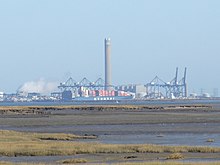London Thamesport
London Thamesport (until June 19, 2008: Thamesport ) is a deep-water port for container handling located northeast of Rochester in Kent . The port, which was built on an industrial wasteland in 1989, is located on the southern part of the Isle of Grain at the mouth of the River Medway in the estuary of the Thames .
history
In the south of the Isle of Grain , which has only been the tip of the Hoo peninsula since an arm of the river was backfilled , the "Kent Oil Refinery", a large oil refinery of the Anglo-Persian Oil Company (later British Petroleum ) , was built after the Second World War . A tank farm with an attached port had existed there since 1928. From 1953 up to ten million tons of crude oil were processed annually in an area of over 4 km² . The nearby oil power stations Grain and Kingsnorth were among the buyers of the mineral oil products manufactured there. After almost three decades, the refinery was closed on August 27, 1982 in favor of modern BP locations. The plant was taken over by the then state-owned company British Gas , which built a facility for storing liquefied natural gas (LNG) on a small part of the area . However, more than three quarters of the area initially remained unused.
In 1987 British Gas presented plans to build a seaport for container handling on 0.87 km² of the fallow refinery site. Construction began in 1989, amid criticism from environmentalists who feared damage to the Thames Estuary's ecosystem. The construction project, which cost 150 million British pounds and was named Thamesport , was financed by the operating company Thamesport Ltd through venture capital . The transshipment operation with a capacity of around 360,000 TEU per year was started as early as March 1990 .
Thamesport was initially only connected on the land side by road, although a railway line from Gravesend to the Isle of Grain was generally available, which was also used by other companies based on the former refinery area. Using a government grant of 1.8 million British pounds, a freight yard with track and transshipment facilities was built on the Thamesport site in January 1992 and was put into operation at the end of the same year.
The agreed repayment of venture capital of around 100 million British pounds led the operating company Thamesport Ltd into financial difficulties in the first half of the 1990s. After a banking consortium temporarily supervised the company, the investment company Rutland Partners LLP acquired 95% of MTS Holdings Ltd - the parent company of Thamesport Ltd - for 25 million British pounds in December 1995 and at the same time assumed the coverage of debts in the amount of £ 27 million. Under the new owner, an expansion of the port was started, increasing the capacity to around 635,000 TEU per year. In 1997 the port was profitable; on sales of £ 27.3 million, pre-tax profits of around £ 2.5 million.
In February 1998 Rutland Partners LLP sold its shares in MTS Holdings Ltd together with a small shipping company called "Maritime Haulage" to the Hutchison Whampoa Group for £ 112 million . With the ports of Felixstowe and Harwich , Hutchison Whampoa also operates two other important ports on the British east coast.
In 2001 Thamesport was expanded into a deep water port . For 3.5 million pounds sterling, the harbor basin was expanded to a target depth of 15.5 meters, the access to a minimum depth of 12.5 meters.
On June 19, 2008 the port was renamed to London Thamesport .
Investments
The core of the port is the 655 meter long quay with six crane runways. A facility with a capacity of 26,000 TEU is available for interim storage. Its 19 cranes take over the placement of containers fully automatically without a crane operator.
A total of around 635,000 TEU can be handled annually in Thamesport. In the long term, capacity is to be doubled through further expansion of the port.
traffic
London Thamesport is connected to Rochester via the A228, Motorway M2 towards Faversham and the multi-lane A2 towards London.
The port also has a connection to the single-track railway line from Hoo Junction ( Gravesend ) to the Isle of Grain , which has been used exclusively for freight traffic since 1961 . Three of the UK's rail freight companies - English, Welsh & Scottish Railway , Fastline Freight and Freightliner - currently use container trains to service London Thamesport. The share of rail in total land-based traffic to and from London Thamesport was around 25% in the first half of 2005.
Individual evidence
- ^ History: This week in Time on the BBC Kent website
- ↑ The Isle of Grain terminal - The return of LNG to the UK ( page no longer available , search in web archives ) Info: The link was automatically marked as defective. Please check the link according to the instructions and then remove this notice. in the LNG Journal , January / February 2004 issue
- ↑ "Thamesport Celebrates Links to the UK's Capital" press release from port operator Hutchison Ports (UK) Limited from June 19, 2008
Web links
- Official website of the port operator (English)
Coordinates: 51 ° 26 ′ 3.7 " N , 0 ° 41 ′ 11.7" E
